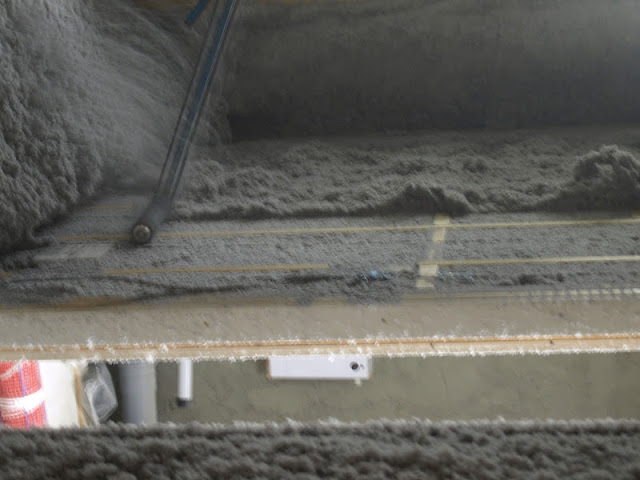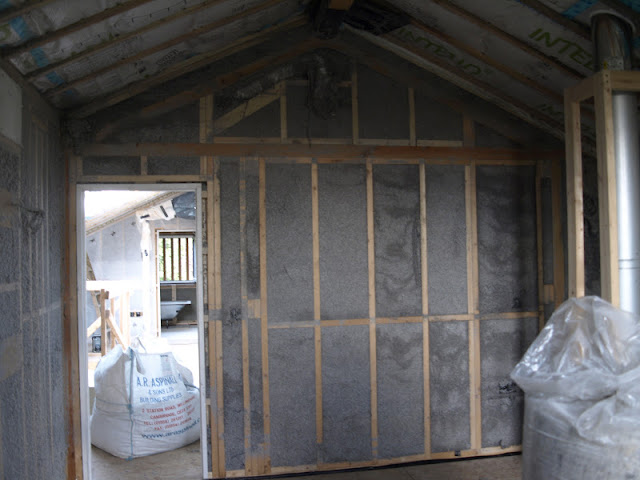Saturday, 30 June 2012
Insulating some last areas
The sheeps wool is back out today to insulate the last few bits..
Like this wall between the study and the hall. This wall was meant to be sprayed with warmcel insulation with the rest of the studwork but because we have framed out for a cupboard they were concerned this would be difficult to do.
We had some sheeps wool left over so put this in instead.
Sunday, 24 June 2012
Tuesday, 19 June 2012
Warmcel insulation part 2 - floors
Part of the first floor over the utility room (with the heat pump) we wanted to fully fill with insulation to give as much soundproofing as possible. The plan was to 'inject' them with warmcel insulation from below (just to be confusing the photo is taken from above!). When we fitted the ceiling boards on the GF ceiling we let off a strip 400mm wide roughly in the centre of the floor, through which a pipe could be inserted into the floor and the insulation blown in. We were told to tape up all gaps, even those only 10mm wide, so I assumed the insulation could be blown with some force. I am not sure this was a correct assumption! The pipe can not really spray any distance and needs to be able to get right to the ends of the joists, which gets increasingly difficult the further you get from the insertion hole. The pipe is flexible and so negotiating it around things like the floor struts is not easy when you get a couple of meters away from the hole! To ensure you reach the end of each joist I think you need to be quite methodical and measure how far in the hose has gone to ensure the insulation has gone right to the end. We ended up taking up the ply on top of the joists to ensure the insulation had gone right to the end. I had thought the beauty of this method of insulation was that you didn't need to take up all the first floor again but I am now not sure it is reliable enough just to trust all joists are fully insulated to the end without checking.
When it came to filling the last section of the floor, where the pipe had been inserted, either mesh can be put over the gap, a hole made in it and the last bit filled (similar to the wall insulation). Or the last bit of ceiling board can be fitted, a small hole cut into it in every joist bay though which the last bit is filled.
We went for the latter as using the mesh was more difficult as one side of the ceiling was hard up against a studwall and so there wasn't a lot to staple the mesh to.
The cut out holes are kept. A small batten is inserted into the hole and screwed to the ceiling board either side and the hole can then be fixed to the batten.
The holes re-fixed.
Monday, 18 June 2012
Warmcel insulation - to mesh or not to mesh
It was the first day of the putting in the Warmcel (recycled newspaper) insulation today into the internal timber studwork walls and also part of the first floor. It was sprayed in using two different methods - open spraying (on the left of the image) and meshed (on the right), where they stapled up a fabric scrim first and then sprayed into the void created.
The insulation is sprayed using different size hoses - a smaller one where it is being injected into a contained void and a larger one when it is being open sprayed.
To start with the walls were open sprayed - this picture is a bit blurry as it was very hard to take a good picture because of all the dust...
...which just filled up the room! Literally everything got covered in a film of newspaper dust. (I am very glad that we taped over the electrical back boxes!)
At the end it looked like this.
You can see the amount of insulation on the floor banked up against the wall.
The insulation then gets flattened off and the overspray and dust tidied up - this takes nearly as long as applying it!
Completed walls using the open sprayed method - they look neat but were incredibly dusty to do. We were told that there was no time limit on how long we could leave the insulation exposed as we were concerned it might fall out of the wall. When they spray it, it is slightly damp so it holds together better and we were worried that when it dried it might fall out of the wall. Whilst it doesn't fall out of the wall as such, if there is a lot of air movement across the surface of it then it does tend to blow out gradually.
In contrast, the meshed walls have a fabric scrim stapled up first as seen here. Holes are made in the mesh in each 'bay' of the wall, for example above and below every noggin and between all the studs. The hose is then inserted into the hole and the void filled up. There is virtually no mess! A definite plus compared to the open spray method in my opinion!
Its is worth noting that where we have the thicker walls, the people installing it found it easier to mesh and fill the entire void. So in places the insulation is about 300mm thick.
Sunday, 17 June 2012
Saturday, 9 June 2012
Saturday, 2 June 2012
Subscribe to:
Comments (Atom)



























